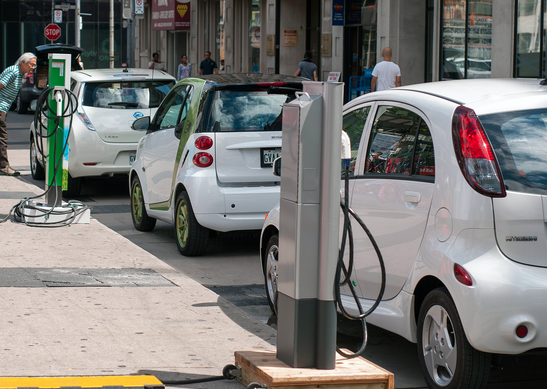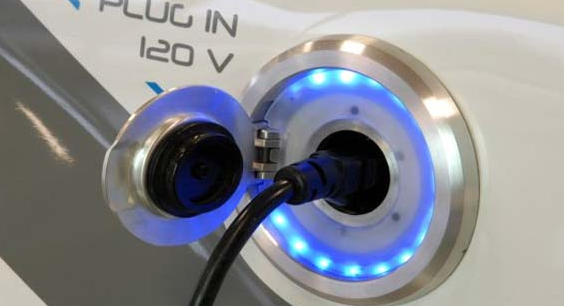Electric Vehicle Sales Need More Charging Stations to Ignite Momentum
According to the latest research, cities with more charging stations have more electric cars.
Sounds simple enough, but herein lies the rub: Investors are less willing to build significantly more charging stations until there are more electric vehicles on the road. The chicken and egg scenario has many scratching their heads for a solution, particularly in a climate of dropping gasoline prices at the pump.
By way of background, in 2011, an important national priority was declared: Put 1 million electric vehicles on the road by 2015. Since then, sales of plug-in electric vehicles have continue to rise, but they pale when compared to sales of conventional vehicles.
Statistics from Argonne National Laboratory show U.S. car dealers sold 97,101 electric vehicles in 2013 and 118,882 in 2014. Meanwhile U.S. car dealers sold more than 13 million passenger cars, light pickup trucks, SUVs and vans in 2013 and more than 14 million in 2014, according to motorintelligence.com.
All told, U.S. car dealers have sold a little more than 250,000 electric vehicles since they were introduced in 2010. This sets the background for an analysis of factors that impact the spread and overall consumer adoption of electric vehicles.
Among those are indirect network effects, factors that impact the sale of electric vehicles beyond point of sale transactions. In this case, consumer reluctance to purchase electric vehicles may influence investor decisions to invest in the electric vehicle market and vice versa.
According to the U.S. Department of Energy (DOE), the high-purchase price gets part of the blame for consumer hesitancy to buy electric vehicles. “While the market is growing quickly, additional cost reduction of electric vehicle technology is required to directly compete on a cost basis with conventional vehicles,” says DOE’s Deputy Assistant Secretary for Transportation Rueben Sarkar.
It’s well known that many electric cars are more expensive than their fossil-fuel powered counterparts. Electric vehicles range in price from about $15,000 to more than $70,000. The cost can be prohibitive, even though, in the long run, electric vehicles can be cheaper to operate. Sakar also points to another reason–consumers are not well acquainted with the technology.
 “Plug-in electric vehicles are a relatively new market coming on the scene a little more than four years ago,” he says. Meanwhile, Lang Tong and Shanjun Li, researchers at Cornell University in Ithaca, N.Y., point to yet another indirect network effect.
“Plug-in electric vehicles are a relatively new market coming on the scene a little more than four years ago,” he says. Meanwhile, Lang Tong and Shanjun Li, researchers at Cornell University in Ithaca, N.Y., point to yet another indirect network effect.
Consumers may be less willing to buy because of a lack of public charging stations, they say. So, consider this: More charging options could lead to more sales.
Tong and Li, whose research is part of a National Science Foundation (NSF)-funded INSPIRE project, contend limited infrastructure to support electric vehicles presents a major roadblock for greater acceptance. The relatively small number of large-scale, public, vehicle-charging stations makes recharging electric vehicles inconvenient, if not impossible at times. Their analysis suggests that more charging stations are needed in parking garages in urban centers, parking lots in shopping malls and parking facilities in apartment complexes and business sites to accommodate consumer demand for convenient electric vehicle refueling.
Using a data set of quarterly electric vehicle sales in 353 metro areas from 2011 to 2013, the researchers found cities with more charging stations also have more electric cars. In their analysis, a 10 percent increase in the number of charging stations per million people in a city would result in a 10.8 percent increase in the market share of electric vehicles in that city.
However, making more charging stations is not as simple as simply opening more stations. The reason: there are different options for electric ‘fueling’; any one vehicle can be charged in more than one way, and different manufacturers may require different charging methods.
In addition, an electric charge depends on and impacts the overall electric grid in the region. Indeed, one major goal of Tong’s and Li’s INSPIRE project is to consider how to engineer transformative technologies for large scale charging of electric vehicles that can work with existing electric grids in a cost-effective way.
“Ultimately, the bigger question is the economic one,” says Tong. “The connection between economic questions and engineering questions comes down to cost. If you have better technology, you will provide more charging services and be able to lower the cost for consumers to charge their vehicles.”
Currently, most owners plug their electric vehicles into a standard 120-volt, home outlet and charge them overnight to get the energy they need for a daily commute.
Others pay to install a 240-volt charging station at home, cutting charging times roughly in half. A third alternative is to purchase an electric vehicle equipped with electrical connections for high, direct-current charging. This can recharge an electric vehicle four to six times faster than an alternating current charger; however the cost for this choice typically runs $15,000 to $25,000.
The researchers believe more efficient charging options that make electricity costs more palatable to consumers would go a long way to speeding up electric vehicle adoption. In addition, the researchers are working to develop efficient, large-scale charging facilities that provide another choice over normal home vehicle charging. To that end, they developed an Intelligent Energy Management System (IEMS) that optimizes the cost of vehicle charging at shopping malls or large parking garages where there are a number of cars that could simultaneously draw energy from the power grid.
Improvements such as these, the researchers believe, could lead to greater adoption of electric vehicles.
The convenience and cost of recharging them is not the only factor that influences the purchase of electrical vehicles. “The $7,500 tax credit policy for which electric vehicle buyers are eligible contributed to about 48.5 percent of electric vehicle sales from 2011 to 2013, which is a significant portion,” says Li, who is an Environmental and Energy Economics assistant professor at Cornell.
“It is important to note that indirect network effects explained 42 percent of that sales increase.” By contributing to sales of nearly half the electric vehicles sold during the research period, some would consider the tax policy a success.
Tong and Li take another view. The researchers maintain the money, which amounted to some $1.05 billion in subsidies, could have been used to build more than 60,000 charging stations instead of giving it to electric vehicle consumers. That number of potential charging stations is significant; it represents about half the total number of gasoline stations in the United States.
Moreover, based on their analysis, Tong, Li and their research colleagues say, 60,000 new charging stations could have led to five times more electric vehicles sold.
However, they report the tax subsidies had a net positive effect. The subsidies during the 2011 to 2013 study period brought about $200 million in long-term environmental benefits.
Category: Electric Vehicles













